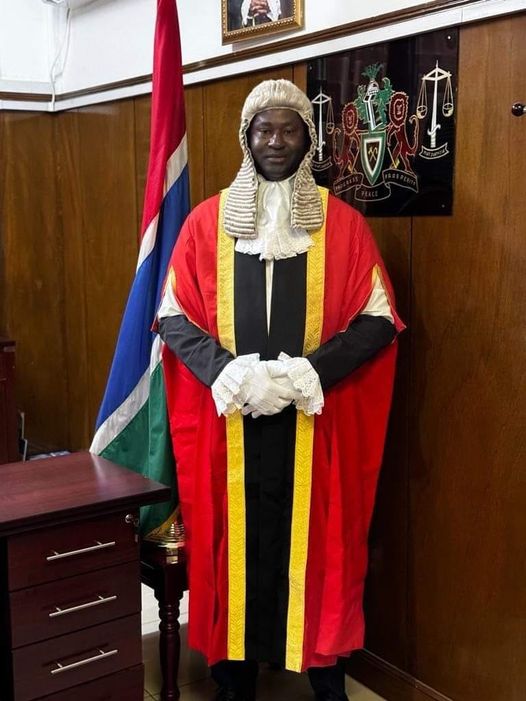By Kemeseng Sanneh (Kexx)
Lamin Lang Sanyang, a convict in the NIA 9 trial made an application to the court seeking clarification regarding his prison sentence.
On the 10th of July 2024, Justice Ebrima Jaiteh provided clarification to his sentence as he also ordered the Director of Prisons to comply with his orders.
By a motion on notice dated and filed on the 3rd of July 2024, Lamin Lang Sanyang sought
an interpretation of his prison sentence. He also asked the court to pass an order directing all the sentences imposed on him to be made to run concurrently.
The motion was supported by a 12-paragraph sworn statement by Lamin Lang Sanyang dated the 4th of July 2024. The Attorney General was served with the said motion. The Attorney General’s Chambers did not file an affidavit (statement) in opposition as they were not opposed to the application.
Justice Jaiteh said he had carefully read the motion paper and its supporting affidavit (statement) and the three documents attached with great interest. He stated that Lamin Lang was seeking an interpretation of his commitment warrant. He added that the issue for determination is whether his Court should give a directive that all the sentences imposed on Sanyang should be made to run concurrently.
The Judge said in the Gambia, sentences in case of conviction of several offences at one trial are governed by section 7 of the Criminal Procedure Code. He referred to section 7(1) which provides that: “When a person is convicted at one trial of two or more distinct offences, the court may sentence him or her for the offences to the several punishments prescribed therefor which the court is competent to impose; the punishment when consisting of imprisonment to commence the one after the other in such order as the court may direct unless the court directs that the punishment shall run concurrently: Provided that sentences of imprisonment in default of payment of a fine whether imposed in addition to substantive terms of imprisonment or not, shall not be directed to run concurrently.”
He said the law is that a convict who is sentenced at one trial of two or more offences may be sentenced to several punishments as prescribed by law, and the punishment is to commence one after the other as the court may direct unless the court directs that the punishment shall run concurrently.
“What this means is that the punishment prescribed as imposed by the Court shall run one after the other unless the said court directs that the sentence should run at the same time,” Justice Jaiteh said.
He held that for a sentence imposed by the court to run at the same time is a matter of discretion of the court. Otherwise, the sentence imposed should run one after the other. This is the position of the law.
Sanyang was the 9th Accused Person in the NIA 9 Trial and was sentenced by the court.
He was sentenced to 10 years imprisonment for count 15, and 10 years imprisonment for count 16 for the offence of Accessory after the fact to murder contrary to section 202 of the Criminal Code. Both sentences shall run concurrently.
He was also convicted and sentenced to 5 years imprisonment for count 17 for the offence of forgery contrary to section 324 of the Criminal Code and sentenced to 5 years imprisonment for Count 18 for the offence of making documents without authority contrary to section 332(a) of the Criminal Code. The sentences shall run concurrently.
He was jointly convicted and sentenced together with Ex-NIA Director General Yankuba Badjie and Ex-NIA Deputy Director of Operations Sheikh Omar Jeng to 5 years imprisonment for count 19 for the offence of fabricating evidence with intent to mislead a tribunal in judicial proceedings contrary to section 98 of the Criminal Code.
Justice Jaiteh stated, “It is worthy to state that in paragraph 5 above, the convict was sentenced in count 15 for 10 years and count 16 for 10 years, and the court directs that both sentences in count 15 and 16 are to run concurrently. The court further sentenced the convict in Count 17 to 5 years and Count 18 to 5 years and thus directed that both Counts 17 and 18 run concurrently.”
The Convict was sentenced in count 19 for 5 years without stating that the said 5 years should run concurrently with other sentences.
“There is no ambiguity that counts 15, 16, 17, and 18 are to run concurrently, and what this means is that all the sentences should operate at the same time. However, the court is silent on Count 19 and by invocation of the principle of “ejusdem generis” in Count 19 where the convict is sentenced to 5 years which is half of the 10 years sentences in other counts are to be run concurrently and it follows that the 5 years sentence imposed in count 19 should also run concurrently or operate at the same time with other sentences which are higher than 5 years.”
Justice Jaiteh relied on Order 6 Rule of the High Court Rules of the First Schedule which thus provides: “Subject to particular rules, the Court may in all causes and make any order which it considers necessary for matters doing Justice, whether such order has been expressively asked by the person entitled to the benefit of the order or not.”
“In view of the fact that this court ordered higher sentences of 10 years to run concurrently, it follows that the lower sentence of 5 years should operate at the same time as time with the sentence of 10 years,” he said.
“It is hereby ordered that all the sentences imposed on the convict Lamin Lang Sanyang (the Applicant herein) shall run concurrently, taking into account when he was first taken into custody. This order is to be served on the Director General of Mile 2 Central Prisons,” Jaiteh said.
















